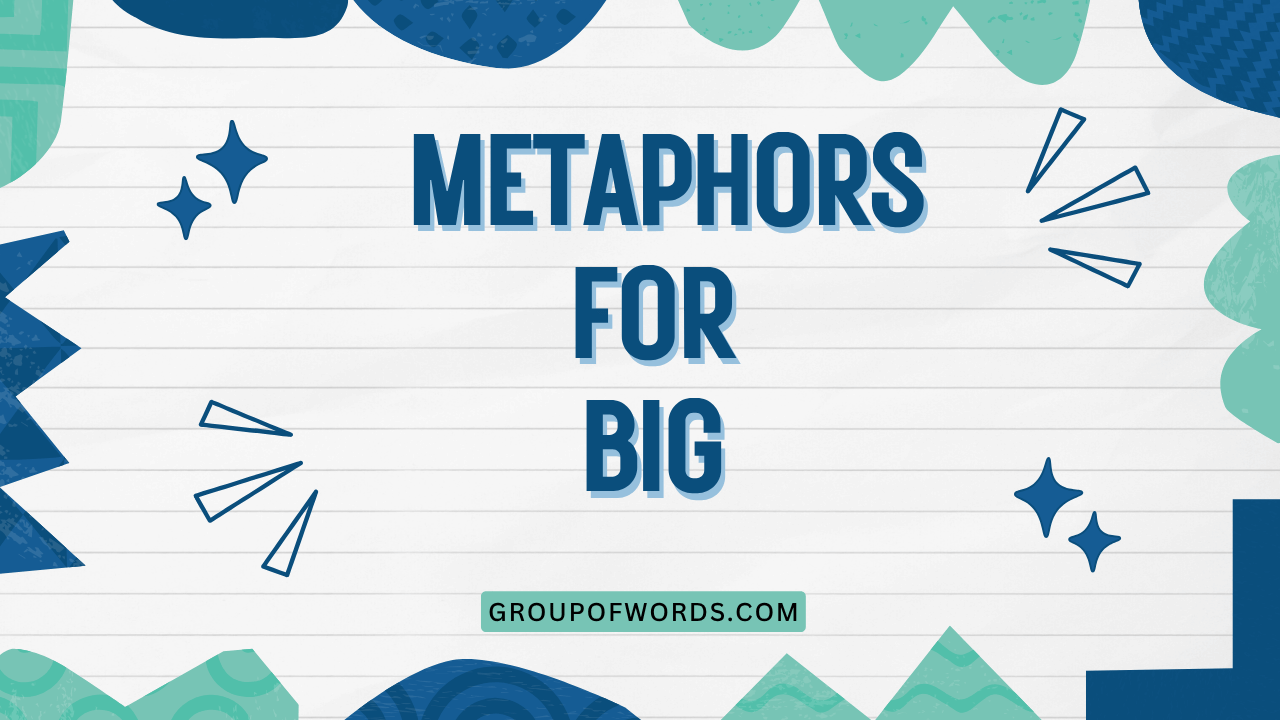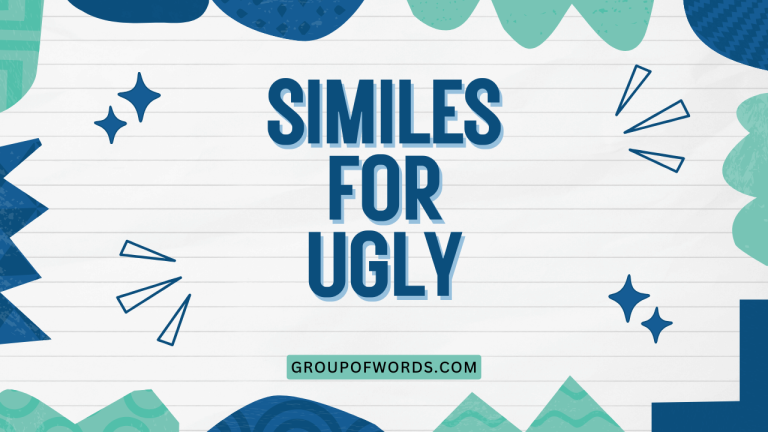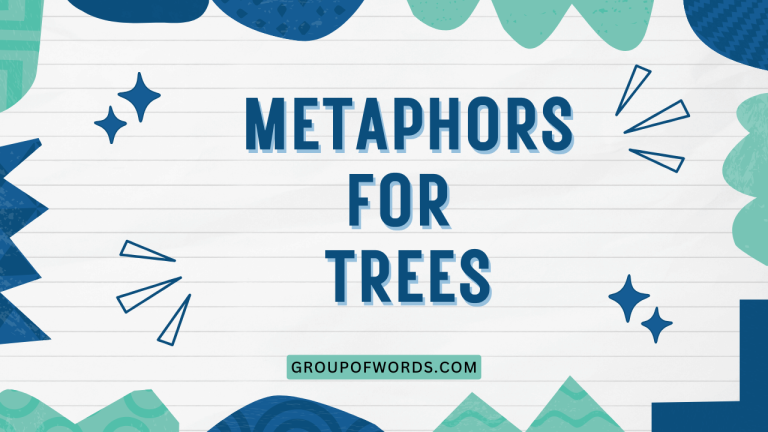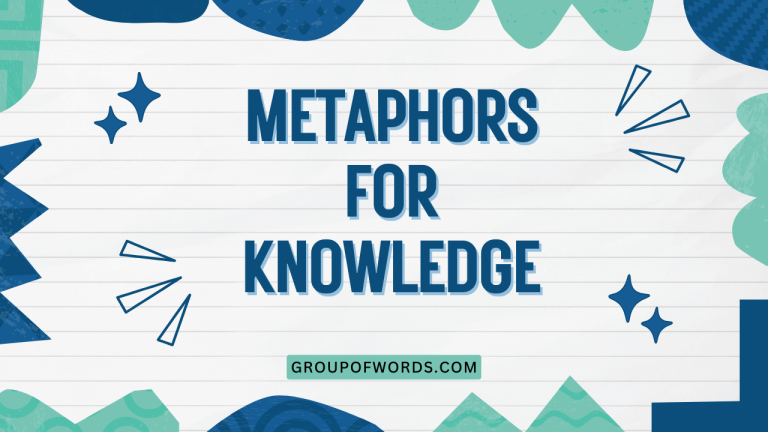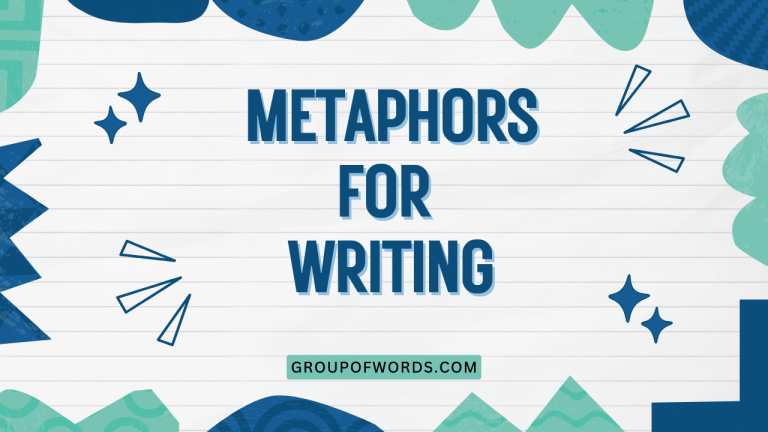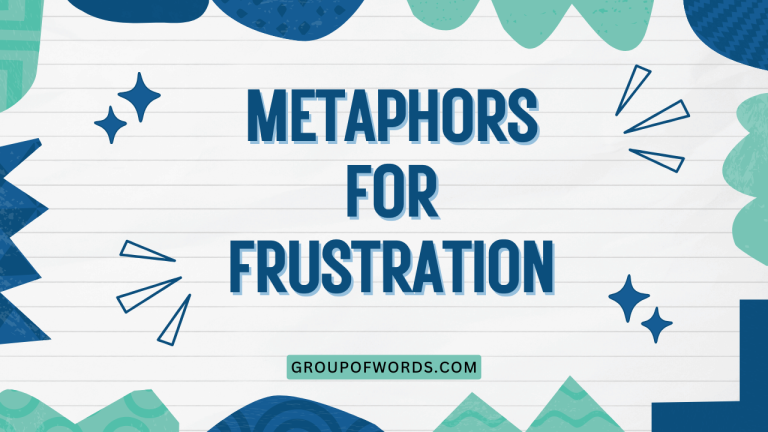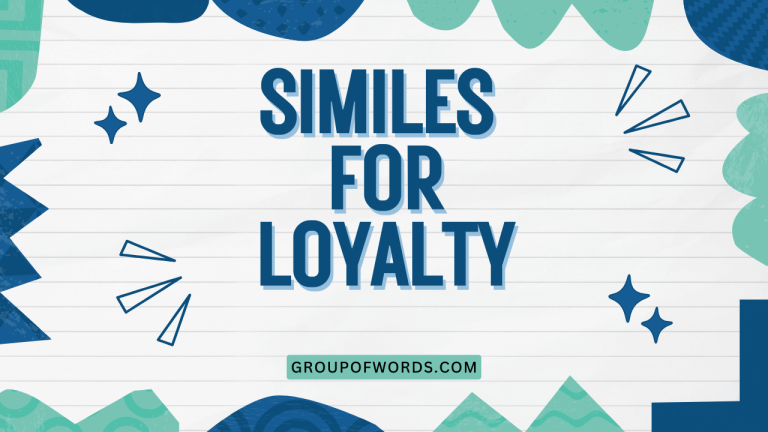Magnifying Meaning: Mastering Metaphors for “Big”
Understanding metaphors is essential for mastering English, as they add depth and color to communication. Metaphors for “big” are particularly useful, allowing us to express size, scale, and impact in creative and impactful ways.
This article explores various metaphors for “big,” providing definitions, examples, and practice exercises to enhance your understanding and usage. Whether you’re an ESL learner or a native speaker, this comprehensive guide will sharpen your language skills and enrich your expressive capabilities.
This article will benefit anyone looking to improve their understanding and usage of figurative language, particularly metaphors related to size and scale. It’s designed for English language learners, writers, educators, and anyone interested in enhancing their communication skills.
By the end of this guide, you’ll be equipped to use metaphors for “big” effectively and creatively, adding nuance and impact to your writing and speech.
Table of Contents
- Definition of Metaphors for “Big”
- Structural Breakdown
- Types and Categories of Metaphors for “Big”
- Examples of Metaphors for “Big”
- Usage Rules for Metaphors for “Big”
- Common Mistakes
- Practice Exercises
- Advanced Topics
- FAQ
- Conclusion
Definition of Metaphors for “Big”
A metaphor is a figure of speech that directly compares two unrelated things, highlighting a shared quality without using “like” or “as.” Metaphors for “big” are used to describe something as large, significant, or impactful by comparing it to something else known for its size, scale, or influence. These metaphors are not literal descriptions but rather imaginative comparisons that evoke a sense of grandeur, importance, or immensity.
In essence, metaphors for “big” transfer the qualities of something large or significant to the subject being described. This can involve physical size, such as comparing a problem to a mountain, or abstract significance, such as describing an achievement as monumental.
The power of these metaphors lies in their ability to create vivid images and convey deeper meaning through association and implication.
The function of these metaphors is to add emphasis, create imagery, and convey emotional impact. They help the listener or reader understand the scale or importance of something more effectively than a literal description might.
The context in which these metaphors are used is crucial; the effectiveness of a metaphor depends on its relevance and appropriateness to the situation and audience. For instance, a metaphor that resonates with a business audience might not be as effective with a younger audience.
Structural Breakdown
The basic structure of a metaphor consists of two main elements: the tenor and the vehicle. The tenor is the subject being described, and the vehicle is the object or concept to which the tenor is being compared. In metaphors for “big,” the tenor is something that is considered large, significant, or impactful, and the vehicle is something that embodies these qualities.
For example, in the metaphor “The challenge was a mountain,” the tenor is “the challenge,” and the vehicle is “a mountain.” The comparison implies that the challenge is as large, imposing, and difficult to overcome as a mountain. The effectiveness of the metaphor lies in the shared characteristic of size and difficulty between the challenge and the mountain.
The implied comparison is crucial in understanding the metaphor. The listener or reader must understand the characteristics of the vehicle (e.g., a mountain’s size and difficulty) and then apply these qualities to the tenor (the challenge).
This creates a deeper understanding of the tenor by associating it with the well-known qualities of the vehicle. The success of a metaphor depends on the audience’s ability to recognize and understand this implied comparison.
Types and Categories of Metaphors for “Big”
Metaphors for “big” can be categorized based on what aspect of “bigness” they emphasize. These categories often overlap, as a single metaphor can convey multiple aspects simultaneously.
However, understanding these categories can help in choosing the most effective metaphor for a particular situation.
Size-Related Metaphors
These metaphors directly compare the size of something to an object or concept known for its large physical dimensions. They often involve comparisons to natural features, such as mountains, oceans, or galaxies, or to large structures, such as skyscrapers or empires.
These metaphors are useful for emphasizing the sheer scale or magnitude of something.
Examples of size-related metaphors include: “The project was a behemoth,” “His ego was as vast as an ocean,” and “The company’s debt was a towering skyscraper.” These metaphors evoke images of immensity and help the listener or reader grasp the size of the subject being described.
Impact-Related Metaphors
These metaphors focus on the significant effects or consequences of something. They often involve comparisons to powerful forces, such as earthquakes, storms, or explosions, or to pivotal events, such as revolutions or turning points.
These metaphors are useful for emphasizing the importance or influence of something.
Examples of impact-related metaphors include: “Her speech was an earthquake in the political landscape,” “The scandal was a tsunami that swept away his reputation,” and “The new policy was a game-changer.” These metaphors convey the idea that the subject has had a profound and transformative effect.
Abstract “Big” Metaphors
These metaphors describe abstract concepts as large or significant, such as ideas, emotions, or achievements. They often involve comparisons to concepts like infinity, eternity, or the universe, or to symbolic representations of greatness, such as monuments or legacies.
These metaphors are useful for emphasizing the importance or lasting impact of something intangible.
Examples of abstract “big” metaphors include: “His love was an endless ocean,” “Her impact on the community was monumental,” and “The possibilities were infinite.” These metaphors convey the idea that the subject is boundless, enduring, or of immense importance.
Examples of Metaphors for “Big”
The following tables provide extensive examples of metaphors for “big,” organized by category. Each example illustrates how the metaphor is used and the effect it creates.
Size Metaphors Examples
This table showcases metaphors that emphasize the physical size or scale of something. Each metaphor uses a comparison to something inherently large to convey the magnitude of the subject.
| Metaphor | Explanation |
|---|---|
| The company’s headquarters was a sprawling metropolis. | Compares the headquarters to a large, expansive city. |
| His ambition was a limitless sky. | Suggests his ambition had no boundaries or restrictions. |
| The amount of data was an Everest of information. | Compares the data to the massive size of Mount Everest. |
| The project’s scope was a boundless ocean. | Implies the project had an immense and unrestricted scope. |
| The crowd was a sea of faces. | Compares the crowd to a vast and overwhelming body of water. |
| The warehouse was a colossal cavern. | Highlights the warehouse’s immense size and emptiness. |
| The problem was a gigantic iceberg. | Suggests the problem was large and potentially dangerous. |
| The estate was a sprawling kingdom. | Compares the estate to a vast and luxurious kingdom. |
| The bureaucracy was a labyrinthine maze. | Implies the bureaucracy was complex and difficult to navigate. |
| The city was a concrete jungle. | Compares the city to a dense and overwhelming wilderness. |
| The national debt was a bottomless pit. | Suggests the debt was so large it could never be repaid. |
| Her wardrobe was a walk-in universe. | Highlights the wardrobe’s extensive collection of clothes. |
| His library was a towering monument to knowledge. | Compares the library to a grand and imposing structure. |
| The amount of paperwork was a never-ending avalanche. | Implies the paperwork was overwhelming and relentless. |
| The festival was a colossal carnival. | Highlights the festival’s immense size and festive atmosphere. |
| The organization was a massive beast, unwieldy and difficult to manage. | Compares the organization to a large, uncontrollable animal. |
| The company’s influence was a global empire. | Suggests the company’s power extended worldwide. |
| The garden was a verdant jungle, teeming with life. | Compares the garden to a lush, overgrown wilderness. |
| The exhibition was a vast panorama of art. | Implies the exhibition offered a wide and diverse range of artwork. |
| The collection was a treasure trove of artifacts. | Compares the collection to a valuable and abundant source of items. |
| The construction project was a Herculean task. | Suggests the project required immense strength and effort. |
| The farm was a gigantic patchwork of fields. | Compares the farm to a large and varied collection of fields. |
| The data center was a digital universe. | Highlights the data center’s immense storage capacity. |
Impact Metaphors Examples
This table illustrates metaphors that emphasize the significant impact or consequences of something. The comparisons are made to events, forces, or phenomena known for their powerful effects.
| Metaphor | Explanation |
|---|---|
| The news was a bombshell. | Suggests the news was shocking and unexpected. |
| His resignation was a seismic event. | Compares the resignation to a major and disruptive earthquake. |
| The new law was a tidal wave of change. | Implies the law caused a significant and overwhelming transformation. |
| Her performance was a thunderbolt of inspiration. | Suggests her performance was sudden, powerful, and inspiring. |
| The merger was a tectonic shift in the industry. | Compares the merger to a fundamental and far-reaching change. |
| The scandal was a wildfire that destroyed his career. | Implies the scandal spread rapidly and caused extensive damage. |
| The discovery was a paradigm shift in science. | Compares the discovery to a revolutionary change in thinking. |
| The revolution was an unstoppable avalanche. | Suggests the revolution was powerful and inevitable. |
| The crisis was a perfect storm of problems. | Compares the crisis to a convergence of multiple negative factors. |
| The invention was a quantum leap forward. | Implies the invention was a significant and rapid advancement. |
| Her words were a dagger to his heart. | Suggests her words were deeply hurtful and damaging. |
| The failure was a crushing blow to his confidence. | Compares the failure to a devastating and impactful event. |
| The victory was a watershed moment in history. | Implies the victory marked a significant turning point. |
| The protest was a roar of discontent. | Compares the protest to a loud and powerful expression of dissatisfaction. |
| The economic downturn was a bitter winter. | Suggests the downturn was a difficult and challenging period. |
| The politician’s speech was a declaration of war. | Compares the speech to an aggressive and confrontational act. |
| The reform was a surgical strike on corruption. | Implies the reform was precise and effective in addressing corruption. |
| The company’s collapse was a house of cards. | Compares the collapse to a fragile and unstable structure. |
| The book was a window into another world. | Suggests the book provided a deep and insightful view. |
| The athlete’s comeback was a phoenix rising from the ashes. | Compares the comeback to a miraculous and resilient recovery. |
| The artist’s exhibition was an explosion of color. | Implies the exhibition was vibrant and visually stimulating. |
| The technological advancement was a game-changer. | Suggests the advancement fundamentally altered the situation. |
| The discovery was a Pandora’s Box of possibilities. | Compares the discovery to a source of numerous and complex issues. |
Abstract Metaphors Examples
This table presents metaphors that describe abstract concepts as large or significant. The comparisons are made to concepts or symbols that represent immensity, importance, or lasting impact.
| Metaphor | Explanation |
|---|---|
| His potential was an untapped universe. | Suggests his potential was vast and unexplored. |
| Her influence was a boundless force. | Compares her influence to an unlimited and powerful force. |
| Their love was an eternal flame. | Implies their love was enduring and unwavering. |
| The opportunity was a golden ticket. | Suggests the opportunity was rare and valuable. |
| His courage was an iron shield. | Compares his courage to a strong and protective barrier. |
| Her wisdom was a deep well. | Implies her wisdom was profound and inexhaustible. |
| The possibilities were an open canvas. | Compares the possibilities to a blank slate ready for creation. |
| His legacy was a towering monument. | Suggests his legacy was grand and enduring. |
| Her dreams were an endless horizon. | Compares her dreams to a limitless and expansive vision. |
| The challenge was a Gordian knot. | Implies the challenge was complex and difficult to solve. |
| His patience was a virtue of steel. | Suggests his patience was strong and unyielding. |
| Her creativity was a flowing river. | Compares her creativity to a continuous and abundant source. |
| The memories were a treasure chest of moments. | Implies the memories were valuable and cherished. |
| His determination was an unshakeable mountain. | Compares his determination to a steadfast and immovable force. |
| Her kindness was a ray of sunshine. | Suggests her kindness was warm and uplifting. |
| His knowledge was an encyclopedia of wisdom. | Compares his knowledge to a comprehensive and authoritative source. |
| Her passion was a burning fire. | Implies her passion was intense and consuming. |
| The potential for growth was a field of dreams. | Compares the potential to a place of endless possibilities. |
| His empathy was a bridge to understanding. | Suggests his empathy facilitated connection and comprehension. |
| Her vision was a beacon of hope. | Compares her vision to a guiding and inspiring light. |
| The experience was a tapestry of emotions. | Implies the experience was rich and complex. |
| His influence was a ripple effect. | Suggests his influence spread gradually and widely. |
| The opportunity was a blank check. | Compares the opportunity to unlimited financial resources. |
| Her love was a sturdy oak. | Implies her love was strong, reliable, and enduring. |
Usage Rules for Metaphors for “Big”
Using metaphors effectively requires careful consideration of context, audience, and the specific qualities you want to emphasize. Here are some key rules to follow when using metaphors for “big”:
- Clarity: Ensure the comparison is clear and easily understood. The audience should be able to recognize the shared qualities between the tenor and the vehicle.
- Relevance: Choose metaphors that are relevant to the subject and the situation. The comparison should make sense in the given context.
- Originality: While common metaphors can be effective, strive for originality to make your writing or speech more engaging and memorable.
- Consistency: Avoid mixing metaphors that create conflicting or nonsensical images. Maintain a consistent tone and theme throughout your use of metaphors.
- Appropriateness: Consider your audience and choose metaphors that resonate with their experiences and understanding. Avoid metaphors that may be offensive or confusing.
Exceptions and Special Cases: Some metaphors have become so common that they are considered clichés. While clichés can be useful for quick and easy communication, they often lack the impact and originality of fresh metaphors. Be mindful of overusing clichés and strive to create more imaginative comparisons.
Additionally, some metaphors may have cultural or regional connotations that can affect their interpretation. Be aware of these nuances and choose metaphors that are appropriate for your intended audience.
Common Mistakes
Using metaphors incorrectly can lead to confusion and diminish the impact of your writing or speech. Here are some common mistakes to avoid:
- Mixed Metaphors: Combining metaphors that create illogical or contradictory images.
- Incorrect: “We need to nip it in the bud before it snowballs into a raging inferno.” (Mixing the idea of stopping something small with something growing massively).
- Correct: “We need to nip it in the bud before it becomes a problem.” or “We need to address the issue before it snowballs out of control.”
- Clichés: Overusing tired and unoriginal metaphors.
- Incorrect: “The project was a huge mountain to climb.” (Clichéd and unoriginal).
- Correct: “The project was a daunting peak, challenging us at every turn.” (More vivid and original).
- Inappropriate Comparisons: Choosing metaphors that are not relevant or appropriate for the context or audience.
- Incorrect: “His presentation was a black hole of information.” (Negative connotation that is unlikely to be intended).
- Correct: “His presentation was a deep dive into the subject matter.” (More appropriate and positive).
- Lack of Clarity: Using metaphors that are too obscure or difficult to understand.
- Incorrect: “The issue was a quagmire of complexity.” (The term “quagmire” might not be familiar to all audiences).
- Correct: “The issue was a complex web of interconnected problems.” (Clearer and more accessible).
Practice Exercises
Test your understanding of metaphors for “big” with these practice exercises. Identify the metaphors, explain their meaning, and create your own examples.
Exercise 1: Identifying Metaphors
Identify the metaphors for “big” in the following sentences and explain what they mean.
| Question | Answer |
|---|---|
| 1. The company’s success was a towering achievement. | The company’s success is compared to a tall, impressive structure, emphasizing its greatness and significance. |
| 2. The environmental damage was a gaping wound on the planet. | The environmental damage is compared to a large, open wound, highlighting its severity and impact. |
| 3. His influence in the community was a force of nature. | His influence is compared to a powerful and uncontrollable natural force, emphasizing its strength and pervasiveness. |
| 4. The amount of information was an overwhelming deluge. | The amount of information is compared to a heavy flood, highlighting its excessiveness and difficulty to manage. |
| 5. The problem seemed like an insurmountable wall. | The problem is compared to a high, impassable barrier, emphasizing its difficulty to overcome. |
| 6. The art museum was a veritable treasure trove of history. | The art museum is compared to a valuable and abundant source of historical artifacts, emphasizing its richness and significance. |
| 7. The project’s budget was a black hole, swallowing funds without end. | The project’s budget is compared to a black hole, emphasizing its insatiable need for funds. |
| 8. The politician’s promises were empty oceans of words. | The politician’s promises are compared to vast but empty oceans, highlighting their lack of substance and sincerity. |
| 9. The challenge ahead was a Herculean task, demanding immense strength. | The challenge is compared to the labors of Hercules, emphasizing its difficulty and the strength required to complete it. |
| 10. Her impact on the field was a monumental legacy. | Her impact is compared to a grand, lasting monument, emphasizing its importance and endurance. |
Exercise 2: Creating Metaphors
Create your own metaphors for “big” to describe the following situations or concepts.
| Situation/Concept | Possible Metaphor |
|---|---|
| 1. A large crowd at a concert | The crowd was a pulsating organism, vibrating with energy. |
| 2. A significant scientific discovery | The discovery was a Rosetta Stone, unlocking new understanding. |
| 3. A company’s rapid growth | The company’s growth was a runaway train, unstoppable and fast-paced. |
| 4. The impact of a major historical event | The event was a ripple in time, changing the course of history. |
| 5. The potential of a new technology | The technology was a seed, promising a harvest of innovation. |
| 6. The size of the universe | The universe is an infinite expanse, a boundless ocean of galaxies. |
| 7. A person’s overwhelming grief | Grief was a tsunami, engulfing her in waves of sorrow. |
| 8. A politician’s broken promises | Promises were a house of cards, collapsing under the weight of reality. |
| 9. The importance of education | Education is the key to unlocking a world of opportunities. |
| 10. The enormity of climate change | Climate change is a sleeping giant, awakening to wreak havoc on the world. |
Advanced Topics
For advanced learners, exploring the nuances of extended metaphors and the cultural context of metaphors can further enhance their understanding and usage.
Extended Metaphors: An extended metaphor is a metaphor that is sustained over several lines or paragraphs, developing the comparison in more detail. This technique can create a richer and more complex image, but it requires careful planning and execution to avoid becoming convoluted or confusing. For example, a writer might compare a person’s life to a journey, and then continue to develop this comparison by describing the challenges, obstacles, and rewards encountered along the way.
Cultural Context: Metaphors are often rooted in cultural experiences and beliefs. Understanding the cultural context of a metaphor is essential for interpreting its meaning accurately. For example, a metaphor that references a specific historical event or cultural tradition may not be understood by someone unfamiliar with that context. Being aware of these cultural nuances can help you choose metaphors that are appropriate and effective for your intended audience.
Analyzing literary works and speeches for their use of metaphors can also provide valuable insights into the art of crafting effective metaphors. Pay attention to how authors and speakers use metaphors to create imagery, evoke emotions, and convey deeper meaning.
FAQ
Here are some frequently asked questions about metaphors for “big”:
- What is the difference between a metaphor and a simile?
A metaphor directly compares two things without using “like” or “as,” while a simile uses “like” or “as” to make the comparison. For example, “The challenge was a mountain” is a metaphor, while “The challenge was like a mountain” is a simile.
- How can I improve my ability to create effective metaphors?
Read widely, pay attention to the language used by skilled writers and speakers, and practice creating your own metaphors. Experiment with different comparisons and ask for feedback from others.
- Are some metaphors for “big” better than others?
The effectiveness of a metaphor depends on the context, audience, and the specific qualities you want to emphasize. Choose metaphors that are clear, relevant, original, and appropriate for the situation.
- Can I use too many metaphors in my writing or speech?
Yes, overusing metaphors can make your writing or speech seem cluttered and confusing. Use metaphors sparingly and strategically to enhance your message, not to overwhelm it.
- How do I avoid mixed metaphors?
Pay close attention to the images created by your metaphors and ensure they are consistent and logical. Avoid combining metaphors that create contradictory or nonsensical images.
- What should I do if I don’t understand a metaphor?
Consider the context in which the metaphor is used and try to identify the shared qualities between the tenor and the vehicle. If necessary, ask for clarification from someone who understands the metaphor.
- How important is originality when using metaphors?
Originality is important because it makes your writing more engaging and memorable. While common metaphors can be effective, strive to create fresh and imaginative comparisons to capture your audience’s attention.
- Why are metaphors important in communication?
Metaphors add depth, color, and emotional impact to communication. They help the listener or reader understand complex ideas and concepts more effectively by relating them to familiar experiences and images. Metaphors also make language more engaging and memorable.
Conclusion
Mastering metaphors for “big” is a valuable skill that can enhance your communication abilities and enrich your understanding of the English language. By understanding the definition, structure, types, and usage rules of these metaphors, you can effectively convey size, impact, and significance in your writing and speech.
Remember to practice regularly, pay attention to the language used by skilled communicators, and be mindful of the context and audience when choosing your metaphors. With dedication and attention to detail, you can harness the power of metaphors to create vivid images, evoke emotions, and convey deeper meaning.
Keep exploring and experimenting with different metaphors to expand your linguistic repertoire and express yourself with creativity and precision.
